The Nine New Plans
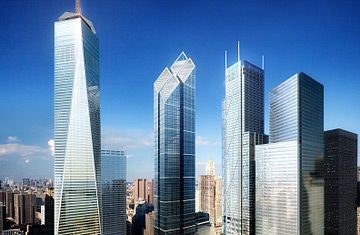
The nine new plans for Ground Zero include four that feature what would be the tallest buildings in the world, and two that create 16 acres of roof-top parks.
Seven design teams, made up of some of the best-known architects in the world, each went beyond the instructions to design a land-use plan, and created specific buildings and memorial spaces. Daniel Libeskind designed a 1,776-foot tower with public gardens, a building that he called "a park standing vertically." The United Architects group designed a group of five buildings that connect on the 60th floor to create a public skyway with gardens, shopping, a sports center and other places.
Where the first round of plans released by the Lower Manhattan Development Corporation in July were panned for all appearing the same, the new plans are aesthetically so different from each other--or at least presented in such different formats--that it is difficult to find points of comparison. "It's overwhelming," said Albert Capsouto, a member of the local community board.
Officials will use the nine new plans, as well as proposals by the mayor and the Port Authority, to determine a master plan by January 31.
Each of the plans adds to the city's skyline and sets aside the physical space where the Twin Towers stood, called the "footprints," for a memorial--one building reflective pools, another an amphitheater in the space. "It is no accident that every plan respects the footprints and restores the skyline," said development corporation president Lou Tomson. Many people had called for these two elements after seeing the first plans.
Each plan includes about the same amount of office and retail space that existed on the World Trade Center site before the attack, said Bob Yaro, president of the Regional Plan Association. "We're basically looking at nice architecture wrapped around the same program," he said. "We need to see some plans based on other uses."
Rick Bell, executive director of the American Institute of Architecture, answered questions about the new plans.
 Gardens of the World Studio Daniel Libeskind |
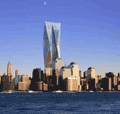 World Square Foster and Partners |
 Memorial Square Richard Meier & Partners Architects, Eisenman Architects et. al. |
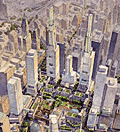 Urban Circle Peterson/Littenberg Architecture and Urban Design |
 Vertical City Skidmore, Owings and Merrill et. al. |
 Sky Memorial United Architects |
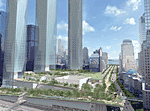 Sky Park THINK |
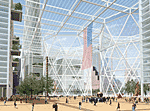 The Great Room THINK |
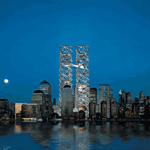 World Cutural Center THINK |
Ground Zero Finalists
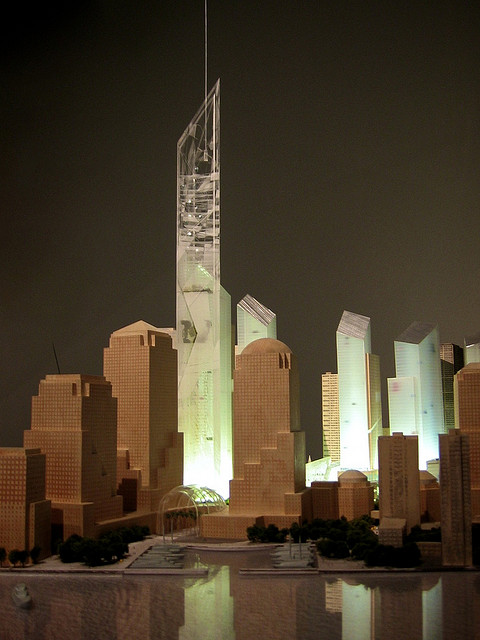
 Gardens of the World by Studio Daniel Libeskind |
On February 4, rebuilding officials narrowed the nine plans for the World Trade Center site down to two.
The committee chose architect Daniel Libeskind, whose plan exposes the Twin Towers' original foundations and leaves the hole at Ground Zero for a memorial, and the THINK team of architects led by Rafael Vinoly and Frederic Schwartz. Their World Cultural Center plan includes two open steel latticework towers with a museum, an amphitheater and other cultural spaces at different heights.
In a four-hour meeting the night before, a selection committee with representatives from the city, the state, the Lower Manhattan Development Corporation and the Port Authority selected the finalists.
Lower Manhattan Development Corporation head planner Alex Garvin said the two plans were chosen because they create inspiring places for the memorial and a cultural district. Both designs also re-connect streets through the site in keeping with Mayor Michael Bloomberg's vision for lower Manhattan. And they both, said Garvin, create spaces that work well for private development.
During the next three weeks, the two design teams will modify their plans based on discussions with rebuilding officials and other key players -- including World Trade Center lease-holder Larry Silverstein, who has said that he doesn't approve of the designs. Officials will then select one finalist. "These plans must be adjusted to reality," said Garvin. "We understand that and so do the designers."
After the final design is selected, Garvin and Port Authority consultant Stanton Eckstut will combine it with transportation, infrastructure and land-use details to create a master plan.
According to Roland Betts, a development corporation board member, the architectural vision that is selected will undergo many changes as it is incorporated into the master plan, but its "core idea" will not be compromised. For example, Betts said, the central vision of the Libeskind design incorporates the original foundations or "slurry walls" of the towers to create a sunken memorial space; this concept would be preserved for the final plan.
"Over time, the best parts of the design will survive," said Port Authority Executive Director Joe Seymour.
The designs by Libeskind and the THINK team will remain on exhibit at the Winter Garden in the World Financial Center until the end of the month. Visitors can submit comments about the plans both at the exhibit and on the development corporation's website.
Gotham Gazette held online chats with THINK team architect Rafael Viñoly and fellow finalist Daniel Libeskind.
Click on the names above for a transcript of each discussion.
A Conversation With Alexander Garvin
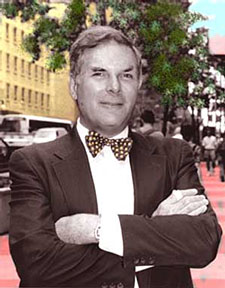 On the afternoon of Tuesday, June 11, Gotham Gazette held a live chat with Alex Garvin, lead planner of the Lower Manhattan Development Corporation. Find out what he said during our conversation as Garvin fielded questions from readers about rebuilding.
On the afternoon of Tuesday, June 11, Gotham Gazette held a live chat with Alex Garvin, lead planner of the Lower Manhattan Development Corporation. Find out what he said during our conversation as Garvin fielded questions from readers about rebuilding.
Gotham Gazette: Good afternoon, everyone, and thank you for coming to Gotham Gazette’s first live chat event. Our guest today is Alex Garvin, the lead planner for the rebuilding effort at the World Trade Center site. Good afternoon, Mr. Garvin.
Alex Garvin: Good afternoon!
GG: We’ll start with our first question. Mr. Garvin, your title is the Vice President for Planning, Design and Development of the Lower Manhattan Development Corporation. What exactly is your job? What are you responsible for? What aren't you responsible for?
AG:I go to meetings, live and online. I answer the telephone. I sign my name and make decisions. But actually, I have to coordinate the participation of all the stakeholders in Lower Manhattan so that the decisions that are taken and the structures that go up will provide a proper remembrance of the events of 9/11; restore Lower Manhattan as quickly as possible; and trigger the revival of Lower Manhattan. I'm not responsible for actually building and neither is the LMDC.
GG: So what is the Lower Manhattan Development Corporation responsible for?
AG:Our mission is rememberance, restoration and revitalization for the entire area south of Houston
GG: Alex Butziger, from Hamburg, Germany, and "tbarzilai" say they want to see the twin towers rebuilt as they were. In fact, in the latest New York Times/CBS poll, twenty-five percent of New Yorkers say they want buildings on the site at least as tall as the twin towers. Is there any possibility of this happening?
AG:New York is a city of possibilities, and our job is to ensure that the most wonderful possibilities happen.
GG: Deputy Mayor Daniel Doctoroff said there is "zero chance" of this happening.
AG:The residents of the New York metropolitan area want their skyline back. How we restore a presence on that skyline remains to be seen, but restore a presence on that skyline we will.
GG: In the New York Times poll, another twenty-six percent say they want the entire site as a memorial, which is what some victims' families say. Is there any chance of that happening?
AG:We are going to rebuild New York in a way which recognizes the events of 9/11, but that rebuilding has to be great. We are holding a public event at the Javits Center on July 20 to receive more public input on alternatives for the site. We will also be holding public hearings through the fall, to hear the public's ideas.
GG: The people who asked this question want to know if a memorial taking up all sixteen acres has been ruled out.
AG:It isn't a matter of size, it's a matter of appropriately honoring the victims, the survivors, the rescuers and the families of all three.
GG: What rebuilding project in history or in the world comes closest to the rebuilding after September 11th, and what lessons can we learn from it?
AG:Rebuilding downtown Warsaw after World War II. The choices that the people of Poland made had a symbolic aspect. They said they would not permit the Nazis to determine what happened in their city. We will not permit criminals to determine what happens in our city.
GG: Everybody agrees the process of rebuilding should involve public participation. But it isn't clear what that actually means - how much this is just lip service, and how much the public will really be involved.
AG:We at the LMDC are dedicated to listening to everybody -- we want the best ideas, and we will work with the Port Authority and all our partners to see whether those ideas are feasible, and affordable, and if they are -- we will present them to the public for comment.
GG: The Lower Manhattan Development Corporation held a public hearing in late May. What did you learn from that public hearing? Did anything surprise you?
AG:We learned that the overwhelming bulk of people who came wanted something great. I had been going to public meetings for a long time. I don't surprise easily. What impressed me was the intensity of feeling. People really care.
GG: There is so much emotion involved in this rebuilding, this is so important to so many people. Can this project meet expectations?
AG:We are going to do our best to see that the very highest expectations are realized. One of our Principles For Action is to promote sustainability and excellence in design. We issued these Principles in March and they will guide the action's of the LMDC. After receiving public input on the Principles and Blueprint during the last few months, we will be issuing the final version this month.
GG: Erma asks: Can a great work of architecture be built in an "open and inclusive process?" or does New York need a Robert Moses, a kind of "czar for rebuilding," for this project?
AG:Central Park was built by New Yorkers in an open public process.
GG: In your previous edition of The American City: What Works, What Doesn't, you say that there are six ingredients for the success of any project. You label them market, location, design, financing, entrepreneurship, and time. Could you go through those, and explain how they apply to the rebuilding of Lower Manhattan. Let's start with market
AG: The second edition, revised and expanded, will be published later this month -- I hope everyone goes out and buys it! On to the market: Our goal is to increase the size of the market served by Lower Manhattan, and that means we need to increase accessibility by ferry, by subway, by rail, so that more people can come to Lower Manhattan.
Now I'll speak about location: Lower Manhattan is blessed by an extraordinary waterfront. One of the things we need to do is to improve accessibility to the waterfront and to provide the maximum number of water-related activities for the people who come to the waterfront.
Now design: Design is not a matter of style. Styles come and go. We have to rebuild Lower Manhattan for the ages. The aspects of design that are important have to do with the arrangement of the components in Lower Manhattan. That means, that where we put additional train or subway service has a great impact on the surrounding properties, so we must be careful in arranging the different public investments that will be made. In addition, we need a great public realm. The buildings that will be built, will be built on this public realm framework. That realm consists of mass transit, streets, squares, parks, bicycle trails, walks...all the places that attract the public.
On to finance. We are very lucky that the President of the US has committed more that $21 billion to the rebuilding of Lower Manhattan - without this we would be in serious trouble. There will be insurance proceeds that can be used to help finance the rebuilding. From the money from Washington, we are already providing assistance to families and individuals iving in Lower Manhattan. As a result, the vacancy rates in Battery Park City and the rest of lower Manhattan have dropped precipitously.
I keep hearing about Robert Moses, who was a great entrepreneur. He had partners, including Mayor Laguardia. Everyone forgets that entreprenuership involves coordinating and inspiring great numbers of people The LMDC, in particular Lou Tomson, our President, is doing his best in inspiring the stakeholders and making it possible for us to use the money from Washington intelligently.
Finally, there is time. Rome wasn't built in a day, and Lower Manhattan will not be rebuilt in a year. We must proceed as quickly as possible, but we cannot sacrifice greatness. That's why we are starting by restoring subway service. The 1-9 train will be functioning by November '01, and the PATH train will be operational by the fourth quarter of 2003. We are beginning with infrastructure. The same is true of our work to see that Con Edison could rebuild its power station by the middle of 2003. These are the beginnings of what will be a long term process, and we are very aware of the need for speed.
GG: mumford asks: How do you expect the plans will address areas like Chinatown and Lower East Side?
AG:We've already announced grants to residents of Chinatown and the Lower East Side. We are devoting most of our attention these first few months to the site of the World Trade Center. As the months go by, we will be working with the residents to create the kind of programs that are suited to those historic neighborhoods.
That was a good question.
GG: Michael Kuo asks: How will you open up and connect the various train lines without tearing down businesses around Ground Zero?
AG:Well, Michael, we don't have to because as we speak the 1-9 is being rebuilt. And there are no residences or businesses anywhere near it. The same is true of the PATH station.
GG: What about the area on Broadway between Fulton and John Streets? A New York Post article mentioned the possibility of having to raze that block to build a transportation hub.
AG:We wrote in our Blueprint that we would examine four possible locations for the PATH station and/or a transit hub. This July, we will be issuing materials that will explain the cost and time involved in each of those alternatives.
GG: nivel asks how PATH rebuilding will not have an impact on Greenwich Village.
AG:I don't understand the question -- Greenwhich Village is a long way from the station.
GG: There is a large protest -- signs in store windows etc. -- about the rebuilding of the PATH train on Christopher Street, and how it will demolish some historic buildings in the neighborhood.
AG:I am not familiar with this situation, but will try to understand what the protest is about.
GG: Is a downtown transportation hub a bigger priority than a project like the Second Avenue subway?
AG:The Second Avenue subway is underway. The transit hub is a proposal. I read the Lexington Ave subway every day -- no one can tell me that the Second Avenue subway is not a priority! Ride, that is!
GG: megalopolis asks: what types of new businesses does Mr. Garvin hope to attract to Lower Manhattan? Is there anything that can be done to attract those specific businesses and industries?
AG:There are a lot of cultural institutions that would like to move to Lower Manhattan that could bring a good deal of activity and charm. They also supply customers at times that there are fewer people working in Lower Manhattan. I think we need a wider variety of retail businesses.
GG: What kinds of businesses?
AG:As I said, a wider variety of retail businesses and cultural attractions.
GG: Some in our audience have questions about specific ideas for the site. Can you comment on some of these?
AG:Yes
GG: One of the ideas reportedly drawn up by Larry Silverstein’s architect is a 110-story tower with the top 40 floors as an empty glass space
AG:I have read about this, but have not seen the proposal, and I never comment on things I haven't seen.
GG: Another idea: Charles Schumer has called for the United Nations downtown
AG:I have heard of this proposal and we're looking into it.
GG: Yet another: Hillary Clinton would like to see a biotech research center
AG:I have also heard of this proposal, and it is under consideration. In our Blueprint, point number 14 calls for the development of Lower Manhattan as a center for biotech companies coordinated with the city's many medical research centers, medical schools and hospitals.
GG: Will a large shopping mall be included?
AG:Westfield Corp leased the retail component of the World Trade Center and they have proposals of this sort. As I said before, we need a greater variety of retail businesses in Lower Manhattan, this is one way to get them.
GG: Everyone says they want to build something "great" downtown. As one member of the audience, John K, asks, what is "greatness?"
AG:Well, John, I bet your notion of greatness is different from your neighbor's. However, we will all know it when we see it.
GG: When and where have you seen greatness?
AG:I grew up in Central Park -- that is greatness.
GG: Now our last question: briggy asks, How will the public be able to continue to have input into the plans as things move forward?
AG: Well, as I mentioned earlier, we are co-sponsoring an event on July 20. It will be held in the Jacob Javits Convention Center, and will use interactive technologies and face-to-face dialogue to consider plans for the redevelopment of Lower Manhattan. To register for the Listening To The City event, please call 1-800-862-3154 or visit http://www.listeningtothecity.org. Thank you - this was fun.
GG: Thank you, Mr. Garvin. It looks like our time is up. Thanks again, Mr. Garvin, for taking this opportunity to answer everyone’s questions. Thanks to everyone else who participated in the chat. If you have a question that was not answered during today’s chat, please email it to This email address is being protected from spambots. You need JavaScript enabled to view it. and we will pass it along to our guest. A transcript of this chat will be available online later today.





